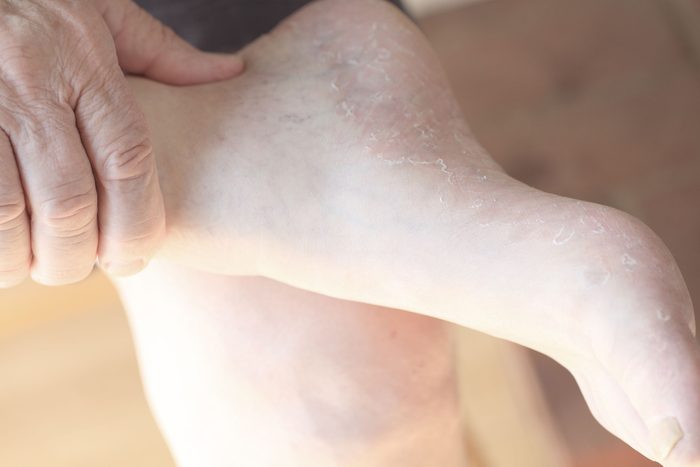
You notice: Dry, flaky feet
It could be: Thyroid problems, especially if moisturizer doesn’t help. When the thyroid gland (the butterfly-shaped gland in the base of your neck) goes on the fritz, it doesn’t properly produce thyroid hormones, which control metabolic rate, blood pressure, tissue growth, and skeletal and nervous system development. “Thyroid problems cause severe dryness of the skin,” says Marlene Reid, DPM, a foot specialist at Family Podiatry Center in Naperville, Illinois. “When we see cracking on the feet, or if moisturizer doesn’t improve dryness over a few days, we usually refer patients to their primary doctor to make sure their thyroids are okay.” Brittle toenails can also signal thyroid complications. (Here’s how to do a thyroid self-exam.)
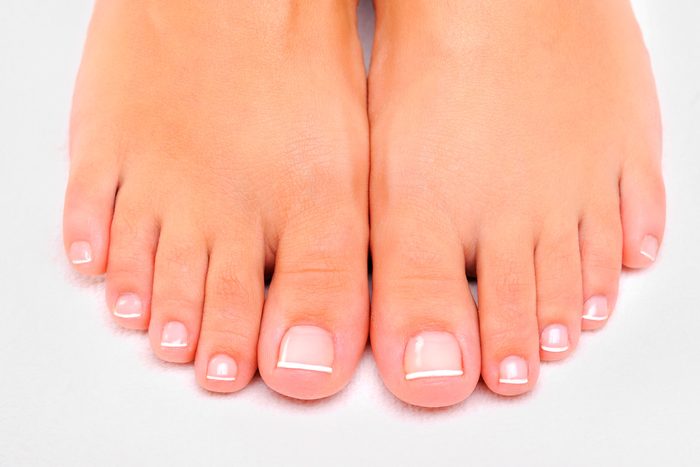
You notice: Bald toes
It could be: Arterial disease. If the fuzz on your toes suddenly disappears, it could signal poor blood circulation caused by peripheral arterial disease (PAD). “Signs of PAD can include decreased hair growth on the feet and ankles, purplish toes, and thin or shiny skin,” says Suzanne Fuchs, DPM, a podiatric surgeon in private practice at Luxe Podiatry in Palm Beach, FL. A buildup of plaque in the leg arteries, PAD affects about 8 million Americans. Symptoms are subtle, but doctors can check for a healthy pulse in the foot or spot PAD on an X-ray. “If I take an X-ray of a broken foot, and I see a hardening of the arteries, 99 percent of the time, the same thing is happening in the heart blood vessels,” says Gary A. Pichney, DPM, a podiatric surgeon of The Institute for Foot and Ankle Reconstruction at Mercy Medical Center in Baltimore.

You notice: Ulcers that don’t heal
It could be: Diabetes. Uncontrolled glucose levels can damage nerves and cause poor circulation, so blood doesn’t reach the feet. When blood doesn’t get to a wound caused by, say, irritating shoes, the skin doesn’t heal properly. “Many, many people with diabetes are diagnosed first because of foot problems,” says Reid. Other signs of diabetes may include tingling or numbness of the feet. Ask your doctor about getting your blood sugar levels tested. Here’s how to get rid of those corns and calluses.
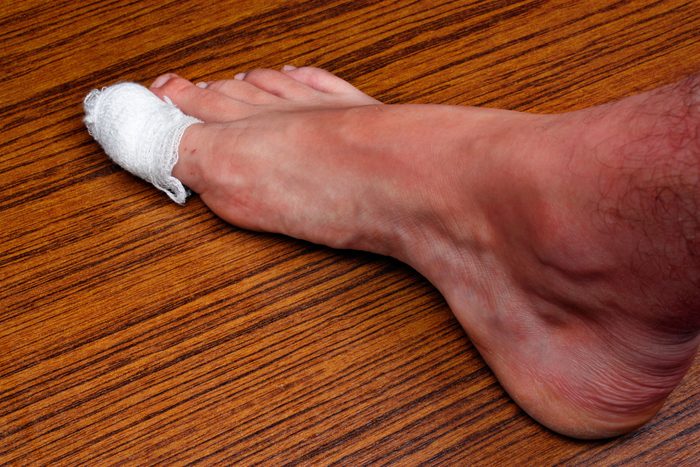
You notice: An enlarged, painful big toe
It could be: Gout. Gorged on wine and steak? The painful aftermath could be gout, a type of arthritis that usually affects the joint of the big toe. Foods high in purine, a chemical compound found in red meats, fish, and certain alcohol, can trigger an attack by raising levels of uric acid in the body. Uric acid is normally excreted through urine, but is overproduced or under-excreted in some people. “You’ll see the deposition of the uric acid in the joint, most commonly the big toe or the ankle,” says Bob Baravarian, DPM, a podiatric foot and ankle specialist at Providence Saint John’s Health Center in Santa Monica, CA. “The patient will wake up with a hard, red, swollen joint. It’s extremely painful.” A doctor may prescribe anti-inflammatory drugs for short-term relief and suggest a low-purine diet for long-term prevention. These foods can do weird things to your body.
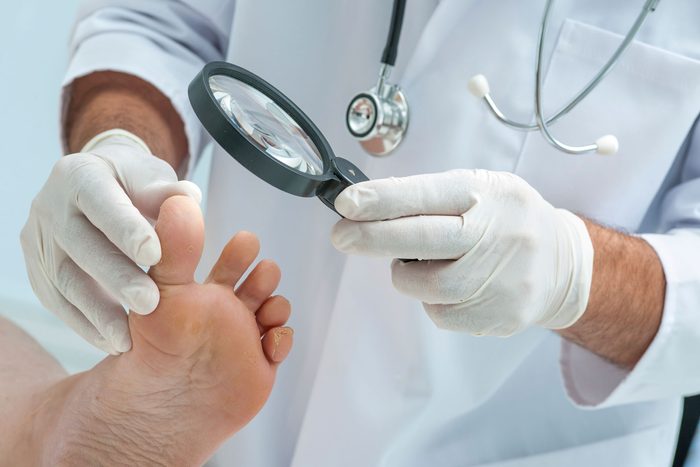
You notice: Small, red lines under the toenail
It could be: A heart infection. Red streaks underneath the toenails or fingernails could be broken blood vessels known as splinter hemorrhages. While problems like psoriasis, fungal infection, or even just experiencing trauma to the nail can cause splinter hemorrhages, it can also be a sign of endocarditis, or an infection of the heart’s inner lining, according to the American Academy of Family Physicians. (Keep in mind this is a rare condition.)
People who have an existing heart condition are at higher risk of developing endocarditis, according to the American Heart Association. The infection can result in heart failure if left untreated. If you notice splinter hemorrhages on your toenails or fingernails, and haven’t experienced any recent trauma to the nail, see your doctor to check your heart and blood circulation. Learn what your nail colour says about your health.
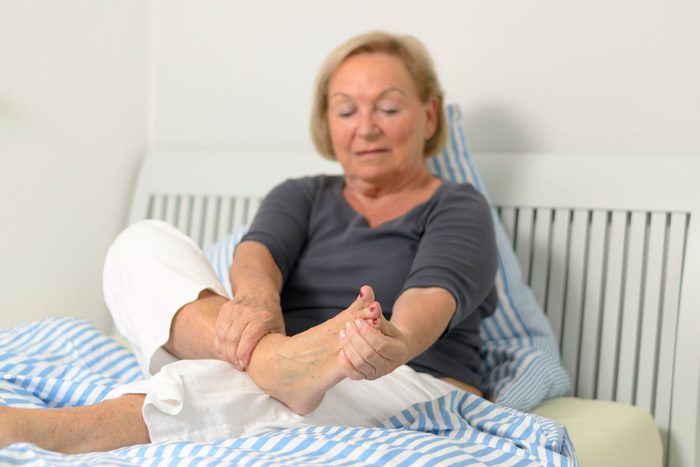
You notice: Clubbing
It could be: Lung cancer or heart disease. Another symptom that appears in both toes and fingers, clubbing is often associated with lung cancer, chronic lung infection, or heart conditions caused by birth defects or infection of the lining of heart valves and chambers, according to Mount Sinai. Clubbing often occurs in these conditions because of the lower amount of oxygen in the blood. The tissue swells and results in the “clubbed” appearance (rounder, wider fingers and toes). Though patients are typically aware they have a disease that is causing the clubbing, it’s best to get checked if you see any abnormalities.
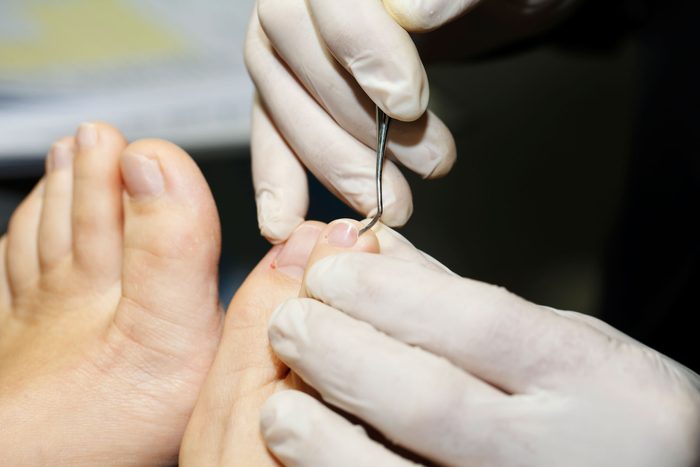
You notice: Pitted toenails
It could be: Psoriasis. If you find tiny holes, grooves, or ridges in your toenails, you may have nail psoriasis. Though most people who experience nail psoriasis also have skin psoriasis (an autoimmune disease that makes skin patchy and irritated), five percent of people with nail psoriasis aren’t affected elsewhere. “If you’ve never been diagnosed with psoriasis, but your toenails have little pits in them, you should get them checked out,” says Pichney. Other symptoms include white patches and horizontal lines across the nails. To treat psoriasis, your doctor may prescribe topical creams or steroids injected under the nail. Here’s what it means if you have ridges on your nails.
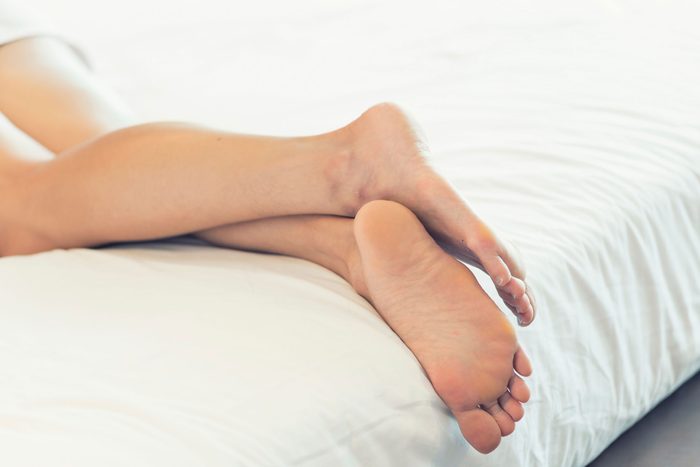
You notice: Spooned nails
It could be: Anemia or lupus. Do you have a depression in the toenail deep enough to hold a water droplet? Also known as koilonychias, spoon-shaped toenails or fingernails is most commonly associated with an iron deficiency, research shows, but it can also come from malnutrition, thyroid disorders, or injury. Spooned nails occasionally appear in infants, but normalize in the first few years of life. If you notice spooning, contact your physician, who will administer a blood test to identify the exact cause. Check out what peeling nails mean.
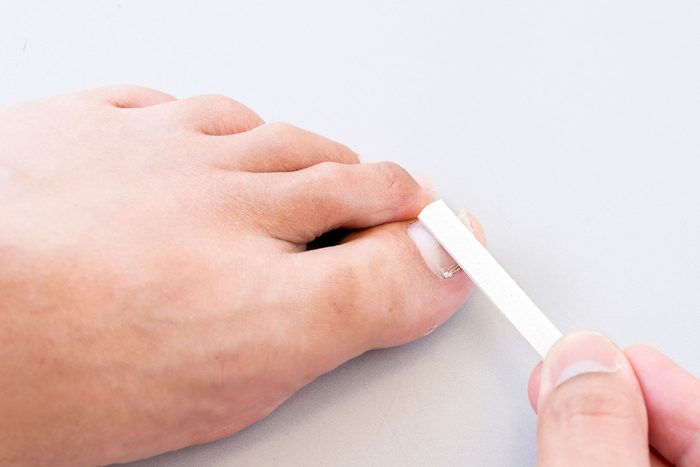
You notice: A straight line under your toenails
It could be: Skin cancer. A dark, vertical line underneath a toenail could be acral lentiginous melanoma, or hidden melanoma—a form of the skin cancer that appears on obscure body parts. (Other hidden melanomas include eye melanoma and mouth melanoma.) “It will be a black line from the base of your nail to the end of the nail,” says Pichney. “It should be seen by a podiatrist or dermatologist. You want to make sure it’s not a fungus, which is usually yellow-brown and sporadic throughout the whole nail.” Don’t ever ignore these pain symptoms.
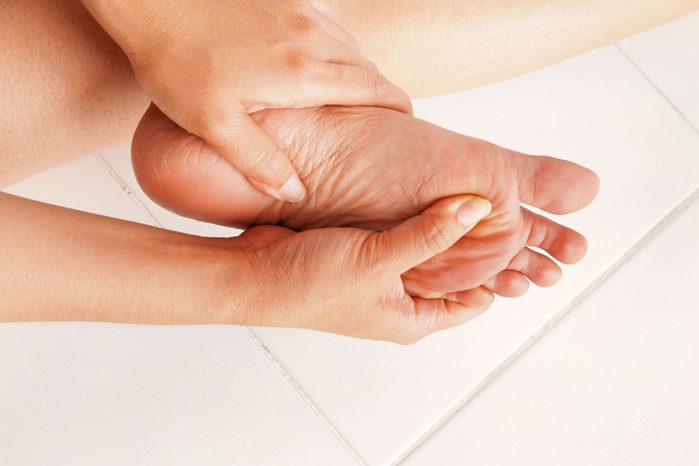
You notice: A suddenly high arch
It could be: Nerve damage. “Most high-arched feet are associated with some form of underlying neuromuscular condition,” says Pichney. “If someone experiences thinning of the arch muscles in the foot, it could be an indication of a neurological condition called Charcot-Marie-Tooth (CMT).” An inherited disorder that damages the peripheral nerves (those outside the brain and spinal cords), CMT can also cause changes in gait, numbness in the feet, difficulty balancing, loss of muscles in the lower legs, and later on, similar symptoms in the arms and hands. See your doctor if you notice abnormalities. “For anything that’s different or changes when it comes to the foot, see your podiatrist right away,” says Reid. Also, watch out for these 42 strange symptoms that signal a serious disease.
